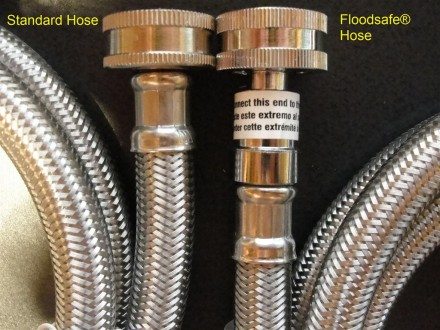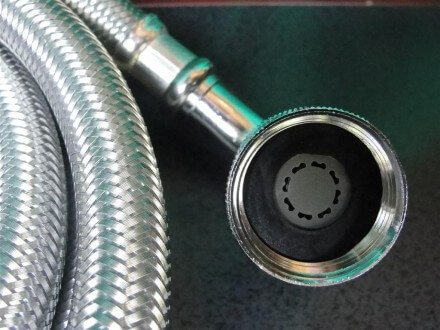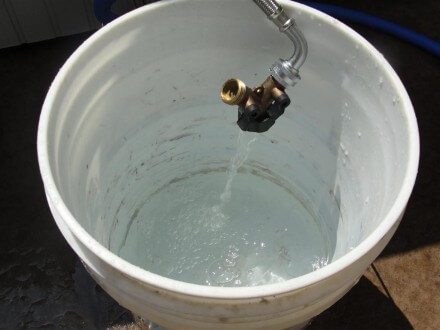In last week’s blog post about washing machine connectors, I mentioned that I’m not a big fan of the FloodSafe® washing machine connectors. These are special flexible water supply connectors, aka ‘hoses’, with a mechanism that will completely shut off the flow of water if the hose bursts. These connectors are made for faucets, toilets, ice makers, dishwashers, and washing machines, and can be identified by an extra length of metal at the hose inlet.
While this is a neat product, I’ve learned that these connectors don’t work properly in a lot of situations – especially when used with washing machines. The problem is that for the safety valve to work properly, it requires a sudden increase in water flow. When a standard washing machine hose has water flowing through it, there wouldn’t be much of an increase in water flow if the hose suddenly burst. So how did they get around this? They created a huge restriction in water flow at the outlet of the hose. The photo below shows a close-up of the flow restrictor.
Without this flow restrictor, the valve won’t work properly; it says so right on the packaging.
I did some playing around with one of these connectors, and I can pretty much guarantee that removing this flow restrictor on a washing machine hose will make it so no water will come out at all. For a quick example of how these devices work, check out the video below. I slowly opened my faucet to increase the water flow. Once the water flow increased enough to dislodge the flow restrictor, the FloodSafe® device immediately shut off the flow of water.
The problem is the restriction in water flow. To determine how much of a difference the flow restrictor made, I compared the water flow to a standard washing machine hose.
I got about 10 gallons per minute with a standard washing machine connector attached to the end of my garden hose, but the FloodSafe® connector only gave me about 1.3 gallons per minute. Pretty pathetic, huh? To take a line from Sweet Brown, ain’t nobody got time for that.
Assuming a standard washing machine uses 40 gallons of water for a large load, this restriction in flow means the washing machine might take an extra half hour with each load of laundry. To make matters worse, newer washing machines have built-in timers, which prevents the water from flowing for too long, in an effort to help prevent major water damage in case there was an internal leak in the washing machine.
Another problem with these connectors is that the fast-acting solenoid valves in a washing machine can create such a sudden increase in water flow that the safety valve treats this as a leak, and shuts off the water. I’ve heard that one way to get around this is to throttle the valve half closed, but now you’re talking about some ridiculously low water flow.
The bottom line is that FloodSafe® connectors are a great idea, but they have their restrictions.
Reuben Saltzman, Structure Tech Home Inspections









Leo jones
July 31, 2012, 5:45 pm
I’ve used these on my modern front load washing machine ( hot and cold ) without any issues. You are complaining about something based on what others have said or what could potentially happen. Your argument is not a valid reason not to use the device.
Reuben Saltzman
July 31, 2012, 7:44 pm
Hi Leo,
I tested this device on my own and determined that it severely restricts water flow. This isn’t based on what others have said or what could potentially happen; it’s a fact.
I’m also not making any kind of argument against using this device; I’m saying that it severely restricts water flow, and it might not work well for everyone.
I’m glad to hear you haven’t had any problems with yours.
Anderson Jon
August 2, 2012, 7:40 am
At Reliable Service-Co we service all major household appliances including washing machines, clothes dryers, refrigerators, freezers, ice makers, ice machines, dishwashers, cooktops, ovens, ranges, stoves, microwaves, vent hoods, trash compactors, and garbage disposals. Some locations also provide repair service for commercial appliances.
When you invite a Reliable Service-Co repair technician into your home, our factory trained and certified technicians will deliver a unique service experience tailored to your situation. From an intensive washing machine repair to a refrigerator needing an adjustment, our technicians will treat you and your home with respect. In fact, due to our superior level of customer service, many of our customers look to Reliable Service-Co as their preferred home appliance repair service provider. We enjoy our work and it shows!
contact http://www.appliancerepairsservices.com/. Its a multispeciality electrical & electronic gadgets repairing/overhauling business establishment. free service call with repair, call toll free no. 888-776-7761.
Replace your old rubber washing machine hoses | Structure Tech Home Inspections
September 12, 2012, 7:46 am
[…] Post edit: Here’s the follow-up: Floodsafe Hoses […]
Eyal
November 23, 2012, 8:29 am
Expereienced EXACTLY the same.
got a new top lod 11 cycle Samsusng washer. the flow restriction elongated the cycle significantly and I just decided to return those. useless.
Mark
February 16, 2013, 1:40 pm
We have these, and have had no problems. If they increased the length of our wash cycle, I didn’t notice, and the washer still is always done before the dryer anyways. We have a Frigidaire Gallery front loader.
David
March 2, 2013, 2:59 pm
I currently have one of these hooked up to my washer in my very small bathroom. I have the 90 degree end hooked up to the wall rather than the washer because of space restrictions. Now water is stuttering coming into the washing machine. Is it possible to remove the valve? or at least make it where it doesn’t work anymore?
Reuben Saltzman
March 2, 2013, 3:33 pm
David – not that I’m aware of. I’m pretty sure you would need to replace the hose.
David
March 2, 2013, 3:00 pm
oops, forgot to check notify me for comments via email.
Phil Pickman
March 18, 2013, 4:06 pm
I used Floodsafe connectors on a Whirlpool Brio washing machine for 4 years. The machine worked just fine.
The washer recently failed. I removed the Floodsafe connector and tested it by connecting the supply side to a hose bib outside. I turned on the water, restricting to flow on the output end with my thumb. The water flowed just fine. I took my thumb off the end, allowing the water to flow freely (simulating a broken hose) and expected the water to stop. It did not. Something has caused the Floodsafe mechanism to lose its protective property. I don’t know what did that, but the connector is no longer protecting me from a broken connector.
Phil Pickman
March 18, 2013, 4:11 pm
to David:
“I have the 90 degree end hooked up to the wall rather than the washer because of space restrictions”.
You hooked up the output end to the water input. That is putting the Floodsafe mechanism backwards. To get the connector to work properly, the 90 degree end must be the output, i.e., connected to the washer.
Steve
March 20, 2013, 5:51 pm
I put a set of these on last night. I was a mover and installed 100’s of washing machine hoses. These were the most difficult hoses to put on and not strip out the connector on the machine.
After messing around with these for a half hour to get them on correctly I tried the machine. No water would come out and the machine made a strange buzzing noise! They are going back tonight.
David
March 23, 2013, 3:33 pm
To Phil Pickman: I realize they’re on backwards b/c there is only about 3 inches between the side wall where the water connection is and the right side ow the washer. Thus, the straight end of the hose would require more room than is there. This is why I’m looking to remove the anti flood valve. Any advice on this situation?
p.s. I’ve already looked into purchasing all the fittings to create a 90 degree fitting to connect the straight end of the hose to. It would be about an additional $30 or $60, I can’t remember exactly.
Phil Pickman
March 23, 2013, 5:07 pm
I cut one of my no-longer-working floodsafe hoses apart with a hacksaw to see if I could figure out why it no longer guards against free flow (I couldn’t – no signs of corrosion).
The mechanism is a spring inside a rubber boot. I don’t see any reasonable way of removing it without destroying the hose coupling.
Alex
April 14, 2013, 5:03 pm
I wish I had found this info sooner. My wife and I recently purchased a small condo as a rental investment. Our home inspector suggested the we change the rubber washer hoses to metal clad ones for increased durability etc. Well of course when I went to the store I saw the “Floodsafe ” hoses and thought that they would be an even better idea.
Our first tenant moved in Friday and this morning (Sunday) I get a text that the washer is not working. No water and a humming sound. I’m going over tomorrow to take a look.
The water and washer had worked fine on our initial inspection and I never thought that there would be this problem when I changed the hoses….We will see….Alex
Phil Pickman
April 15, 2013, 12:47 pm
I sent the second (intact) washer hose (no longer working) that I removed back to FloodSafe (Watts) so they could examine it and tell me why it won’t properly turn the water off when it’s not connected to anything. FloodSafe reported that they took the mechanism apart and found sediment in the device, holding it open. They said it might be from sediment in the water line – maybe introduced when the hoses were first connected after the house was built. That could be. I can’t confirm the source of the sediment. My water supply for the house all goes through a carbon filter and water softener (using KCl) prior to entering the house.
Alex
April 15, 2013, 5:10 pm
I wish I had found this info sooner. My wife and I recently purchased a small condo as a rental investment. Our home inspector suggested the we change the rubber washer hoses to metal clad ones for increased durability etc. Well of course when I went to the store I saw the “Floodsafe ” hoses and thought that they would be an even better idea.
Our first tenant moved in Friday and this morning (Sunday) I get a text that the washer is not working. No water and a humming sound. I’m going over tomorrow to take a look.
The water and washer had worked fine on our initial inspection and I never thought that there would be this problem when I changed the hoses….We will see….Alex
After reading all the negative comments and experiences, I just changed the hoses back to regular metal clad. The washer works just fine now. Went two cycles with out a problem….Thank you all so much for the info. Great to have a place to go to.
David
June 4, 2013, 7:54 pm
READ THE INSTRUCTIONS! Turn the water on at the faucet SLOWLY and they will work just fine.
Dennis
July 6, 2013, 1:34 am
I purchased these for the 5 year maintenance replacement.Followed the instructions and no matter how I turned on the faucets, The hoses shut the flow to the washer as soon as fill started. I reset 4 times and only turned faucet one turn. Was able to get cold working but hot still shut down DO NOT BUY_A BIG WASTE OF MONEY
Ed
August 17, 2013, 8:48 pm
I installed the Floodsafe washing machine hoses on my washing machine (located on the 2nd floor) about 6 months ago and everything worked fine. And I felt better about not having a hose burst and flood both floors of my house. A few days ago a new water line was run from the street into my house. There was air in my water lines as I opened the faucets throughout my house. Now the washing machine is not getting any water. I think that the air in the line might have triggered the Floodsafe device. Does this sound correct? Any idea how I should fix it?
Reuben Saltzman
August 18, 2013, 5:35 am
Ed – disconnect and then re-connect the Floodsafe hoses.
Chris C.
August 22, 2013, 8:53 am
I came here after getting several issues with clogging of the inlet valve of our dishwasher. We are on well water and with the sand and small debris passes right through the inlet screen, clogging the restrictor disk and every year or so, I end up having to remove the machine and put it upside down to access the inlet valve and carefully clean that poorly conceived device with a needle.
Considering we are 30 miles from the nearest parts centre and the cost, this has become a major pain in the a**.
Is there a practical way to GUT THAT USELESS PIECE OF C*** out of the valve so it will flow in a normal manner WITHOUT RESTRICTIONS?
I am truly getting sick and tired of all the junk that has cropped up in recent appliances and gadgets, which have made them less reliable so much so that nowadays people don’t think twice throwing out an appliance after 5 or 10 years, often for a simple thing that is just too costly to service.
In this day and age of economic hardships and concern for the environment, I can’t understand how we let our regulators impose these useless devices that end up causing more products to be needlessly discarded because some lawyer somewhere decided we were too stupid to replace a simple hose.
This particular device may have its uses, but it should be optional and easily user removable.
Chris C.
August 22, 2013, 1:03 pm
For those who are looking for a solution and who have suffered from poor diswasher performance: do yourself a favor and REMOVE THAT PIECE OF C**** from your water inlet valve, you’ll be glad you did!
If like me the device was fitted into the inlet valve at the factory, the restrictor disk was press fitted into a grove of the valve body but you can pry it out using a pair of small needle nose pliers into those restrictor holes, twist it sideways and it should come off and the rubber valve behind it 🙂
As a result, the washing machine now fills in a matter of 30 seconds instead of five minutes and it’s really spraying now when washing, as if there was an industrial pressure washer in there! As a result, my dishes are better cleaned now in one normal cycle than they ever were even in “pots and pans” mode!
Heck, with this improvement we may even be able to bypass our pre-rinse routine before putting dishes in the machine!